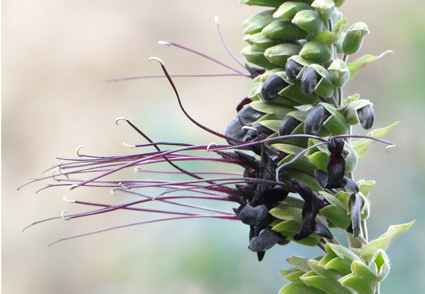Abstract
Salvia alata is reported as new record for Ecuador. This species belongs to S. sect. Macrostachyae, thus an updated identification key to species of this section is provided. The descriptions of Salvia alata and the species most morphologically similar to it (Salvia speciosa) are complemented with new information and photographs taken in the field. Salvia alata is distributed in Ecuador and Peru and can be distinguished from Salvia speciosa by its pilose vegetative organs, flowers with white stamens and styles, and mericarps with a deltoid apex. On the other hand, Salvia speciosa is endemic to Peru, and it has glabrescent vegetative organs, flowers with burgundy to deep purple stamens and styles, and mericarps with a bifurcate apex.
References
Bentham, G. (1832–1836) Labiatarum Genera et Species. James Ridgway and Sons, London, 745 pp.
Bentham, G. (1848) Labiatae. In: de Candolle, A. (Ed.) Prodromus Systematis Naturalis Regni Vegetabilis. Victor Masson, Paris, pp. 27–603.
Bouman, F. & Meeuse, A.D.J. (1992) Dispersal in Labiatae. In: Harley, R.M. & Reynolds, T. (Eds.) Advances in Labiate Science. Royal Botanic Gardens Kew, Richmond. pp. 193–202.
Epling, C. (1935–1937) Synopsis of the South American Labiatae. Repertorium Specierum Novarum Regni Vegetabilis 85: 1–341.
Epling, C. (1939) A revision of Salvia subgenus Calosphace. Repertorium Specierum Novarum Regni Vegetalis 110: 1–380.
Epling, C. (1940) Supplementary Notes on American Labiatae. Bulletin of the Torrey Botanical Club 67: 509–534. https://doi.org/10.2307/2480972
Epling, C. (1941) Supplementary notes on American Labiatae-II. Bulletin of the Torrey Botanical Club 68: 552–568. https://doi.org/10.2307/2481456
Epling, C. (1944) Supplementary notes on American Labiatae-III. Bulletin of the Torrey Botanical Club 71: 484–497. https://doi.org/10.2307/2481241
Epling, C. (1947) Supplementary Notes on American Labiatae-IV. Bulletin of the Torrey Botanical Club 74: 512–518. http://dx.doi.org/10.2307/2481876
Epling, C. (1951) Supplementary Notes on American Labiatae-V. Brittonia 7: 129–142. https://doi.org/10.2307/2804702
Epling, C. (1960) Supplementary Notes on American Labiatae-VII. Brittonia 12: 140–150. http://dx.doi.org/10.2307/2805214
Epling, C. & Játiva, C. (1963) Supplementary Notes on American Labiatae-VIII. Brittonia 15: 366–376. http://dx.doi.org/10.2307/2805381
Epling, C. & Játiva, C. (1966) Supplementary Notes on American Labiatae-IX. Brittonia 18: 255–265. http://dx.doi.org/10.2307/2805366
Epling, C. & Játiva, C. (1968) Supplementary Notes on American Labiatae-X. Brittonia 20: 295–313. http://dx.doi.org/10.2307/2805687
Epling, C. & Mathias, M. (1957) Supplementary notes on American Labiatae-VI. Brittonia 8: 297–313. http://dx.doi.org/10.2307/2804980
Fernández-Alonso, J.F. (2003) Estudios en Labiatae de Colombia IV. Novedades en Salvia y sinopsis de las secciones Angulatae y Purpureae. Caldasia 25: 235–281.
Fernández-Alonso, J.F. & Rivera-Díaz, O. (2006) Las labiadas (Familia Labiatae). In: García-Castro, N.J. & Galeano, G. (Eds.) Libro Rojo de Plantas de Colombia. Volumen 3. Las bromelias, las labiadas y las pasifloras. Instituto de Investigación de Recursos Biológicos Alexander von Humboldt, Instituto de Ciencias Naturales de la Universidad Nacional de Colombia, Ministerio de Ambiente, Vivienda y Desarrollo Territorial, Bogota. pp. 385–582.
Fragoso-Martínez, I., Martínez-Gordillo, M., Salazar, G.A., Sazatornil, F., Jenks, A.A., García Peña, M. del R., Barrera-Aveleida, G., Benitez-Vieyra, S., Magallón, S., Cornejo-Tenorio, G. & Granados Mendoza, C. (2018) Phylogeny of the Neotropical sages (Salvia subg. Calosphace; Lamiaceae) and insights into pollinator and area shifts. Plant Systematics and Evolution 304: 43–55. https://doi.org/10.1007/s00606-017-1445-4
González-Gallegos, J.G., Bedolla-García, B.Y., Cornejo-Tenorio, G., Fernández-Alonso, J.L., Fragoso-Martínez, I., García-Peña, M.R., Harley, R.M., Klitgaard, B., Martínez-Gordillo, M.J., Wood, J.R.I., Zamudio, S., Zona, S. & Xifreda, C.C. (2020) Richness and distribution of Salvia subgenus Calosphace (Lamiaceae). International Journal of Plant Sciences 181 (8): 831–856. https://doi.org/10.1086/709133
Harley, R.M. (1999) Lamiaceae. In: Jørgensen, P.M. & León-Yánez, S. (Eds.) Catalogue of vascular plants of Ecuador, Monographs in Systematic Botany from the Missouri Botanical Garden 75, Missouri Botanical Press, St. Louis, pp. 519–526.
Harley, R.M., Atkins, S., Budantsev, A.L., Cantino, P.D., Conn, B.J., Grayer, R., Harley, M.M., de Kok, R., Krestovskaja, T., Morales, R., Paton, A.J., Ryding, O. & Upson, T. (2004) Labiatae. In: Kadereit, J.W. (Ed.) The families and genera of vascular plants. Vol 7. Springer, Berlin, pp. 167–275.
Jenks, A.A., Walker, J.B. & Kim, S.-C. (2013) Phylogeny of New World Salvia subgenus Calosphace (Lamiaceae) based on cpDNA (psbA-trnH) and nrDNA (ITS) sequence data. Journal of plant research 126: 483–496. https://doi.org/10.1007/s10265-012-0543-1
Kunth, C.S. (1818) Nova genera et species plantarum. The Greek-Latin-Germanic Library, Paris, 404 pp.
Lagomarsino, L.P., Condamine, F.L., Antonelli, A., Mulch, A. & Davis, C.C. (2016) The abiotic and biotic drivers of rapid diversification in Andean bellflowers (Campanulaceae). New Phytologist 210: 1430–1442. https://doi.org/10.1111/nph.13920
Linnaeus, C. (1753) Species plantarum. Salvius, Stockholm, 1200 pp.
MacBride, J.F. (1960) Labiatae. In: MacBride, J.F. (Ed.) Flora of Peru, Vol 13, pt V, no 2. Field Museum of Natural History, Chicago, pp. 721–829.
Moscoso, A., Montúfar, R. & Tye, A. (2011) Lamiaceae. In: León-Yánez, S., Valencia, R., Pitman, N., Endara, L., Ulloa Ulloa, C. & Navarrete, H. (Eds.) Libro rojo de las plantas endémicas del Ecuador, Publicaciones del Herbario QCA, Pontificia Universidad Católica del Ecuador, Quito. pp. 367–371.
Rodriguez, M. (2006) Lamiaceae endémicas del Perú. Revista Peruana de Biología 13: 371s–379s.
Tank, D.C., Eastman, J.M., Pennell, M.W., Soltis, P.S., Soltis, D.E., Hinchliff, C.E., Brown, J.W., Sessa, E.B. & Harmon, L.J. (2015) Nested radiations and the pulse of angiosperm diversification: increased diversification rates often follow whole genome duplications. New Phytologist 207: 454–467. https://doi.org/10.1111/nph.13491
Ulloa-Ulloa, C., Acevedo-Rodríguez, P., Beck, S., Belgrano, M.J., Bernal, R., Berry, P.E., Brako, L., Celis, M., Davidse, G., Forzza, R.C., Robbert Gradstein, S., Hokche, O., León, B., León-Yánez, S., Magill, R.E., Neill, D.A., Nee, M., Raven, P.H., Stimmel, H., Strong, M.T., Villaseñor, J.L., Zarucchi, J.L., Zuloaga, F.O. & Jørgensen, P.M. (2017) An integrated assessment of the vascular plant species of the Americas. Science 358: 1614–1617. https://doi.org/10.1126/science.aao0398
Wester, P. & Claßen-Bockhoff, R. (2011) Pollination syndromes of New World Salvia species with special reference to bird pollination. Annals of the Missouri Botanical Garden 98: 101–155. https://doi.org/10.3417/2007035
Wood, J. & Harley, R. (1989) The genus Salvia (Labiatae) in Colombia. Kew Bulletin 44: 211–278.
Zona, S. (2017) Fruit and seed dispersal of Salvia L. (Lamiaceae): a review of the evidence. The Botanical Review 83: 195–212. https://doi.org/10.1007/s12229-017-9189-y


